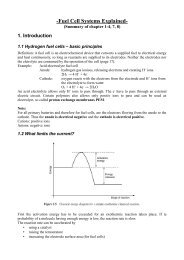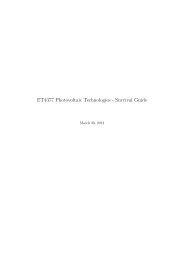Fuel Cell Systems Explained - from and for SET students
Fuel Cell Systems Explained - from and for SET students
Fuel Cell Systems Explained - from and for SET students
Create successful ePaper yourself
Turn your PDF publications into a flip-book with our unique Google optimized e-Paper software.
With Pe: electrical Power of the stackVc: voltage of a single cellṅ O2 : supply or use rate of oxygenλ: air stoichiometryThe exit flow rate of the non-oxygen components of air is the same as in the inlet. The non-oxygencomponents amount to 79% of the air. This will be graeter than the oxygen molar flow rate by thefactor 0.79/0.21 = 3.76.Substituting the molar flow rates in the first equation deliversThe water vapour pressue at the outlet only depends on the air stoichiometry <strong>and</strong> the air pressure atthe exit. This eqution gives the worst case conditions, not water vapour in the inlet.If the realtive humidity of the excess air is too dry, it could be changed by lowering temperature → increase losses lowering air flow rate <strong>and</strong> hence λ → reduce cathode per<strong>for</strong>mance increasing pressure → more enrgy <strong>for</strong> the compressorNone of these options is really attractive.Another option is to extract the water of the excess air <strong>and</strong> supply it to the reactants at the inlet. Thisrequires additional equipment, extra costs, but is often justified by an increased per<strong>for</strong>mance. Thewater pressure can be derived, taking the humidity of the inlet air into account, is given bywith4.4.4 Running PEM fuel cells without extra humidificationIt is possible to run a PEM fuel cell at the right conditions without external humidification, bychoosing suitable operating temperatures <strong>and</strong> air flowrates.






